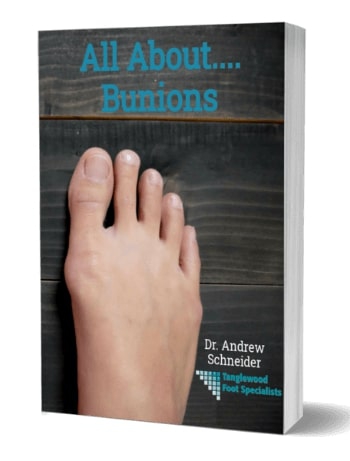 When you think of bunions, which are unnatural, bony humps that form at the base of the big toe where it attaches to the foot, you often think of grandmothers, forced to wear sensible, unattractive shoes in order not to aggravate the deformity.
When you think of bunions, which are unnatural, bony humps that form at the base of the big toe where it attaches to the foot, you often think of grandmothers, forced to wear sensible, unattractive shoes in order not to aggravate the deformity.
But grandmas aren’t the only ones affected by bunions. According to an analysis of data published in the Journal of Foot and Ankle Research, an estimated 23% of adult Americans suffer from bunions. More than 2/3 of adults over 65 will develop a bunion, and more than 50% of women get bunions. While once this was considered an older woman’s problem, the growing popularity of high heels and pointy-toed shoes has led to an increased number of younger women suffering from bunions. But why do you get these bumps? And should you choose traditional bunion surgery or the Lapiplasty procedure to get rid of these bumps for good? Here's what you need to know!
Why Bunions Form
Bunion growth is genetically determined. But unusual motion or undue pressure, particularly the kind inflicted by ill-fitting shoes, can trigger a bunion to form. In other words, your shoes can’t cause you to develop a bunion, but they can awaken your genetic predisposition, causing one to form.
Once a bunion has developed, Houston podiatrist Dr. Andrew Schneider will usually start treatment with a non-surgical option, like custom orthotic insoles. While this approach can prevent a bunion from getting worse, it won’t correct the problem. Once a bunion has formed, surgery is the only way to remove it.
Traditional Bunion Surgery
There are many different surgical approaches used to correct bunions. The right treatment for you will depend on the nature and severity of your problem. In the past, recovery time from bunion surgery was usually between six and 12 weeks. And that often included time on crutches and in surgical shoes or boots. While older patients may choose to live with palliative treatments, saying goodbye to stylish shoes forever, younger patients often choose to surgically remove bunions in order to keep wearing more fashionable footwear. Luckily, we've recently adopted a new approach to bunion surgery: the Lapiplasty procedure. It works differently, taking a three-dimensional approach to bunion correction. It's also less invasive. So, in combination? You can say goodbye to bunions with a faster recovery time. And the bunions are less likely to return in the future!
What is the Lapiplasty® Procedure?
Unlike other types of bunion surgery, the Lapiplasty procedure corrects every aspect of your bunion deformity. It:
1. Stops the metatarsal bone from tilting inward toward the other toes.
2. Prevents bone rotation, reducing your risk for pain and arthritis.
3. Stops the bone from arching upward, taking pressure off of your other toes.
By treating bunions in these three ways, we describe Lapiplasty as taking a “3D” approach. It also stabilizes the joint, so bunions don't come back. Plus, it's performed with a patented instrument that allows for smaller and fewer incisions in your foot, decreasing your post-operative pain and downtime. In fact, you should be able to bear weight within three days of your procedure. (In a walking boot, of course.) After six to eight weeks, you'll be out of that boot and in supportive footwear, getting back to all your favorite activities. (Except for high-impact sports or workouts.) And, after about four months, you should be cleared for all activity.
Why Choose the Lapiplasty® Procedure Over Traditional Bunion Surgery?
Lapiplasty gets rid of that bony bump beneath your big toe joint, just like other bunion surgeries. But it doesn't stop there. Instead, it also addresses the root cause of bunion formation. And, the surgery is more precise and less invasive than a traditional bunionectomy, reducing pain and getting patients back on their feet much faster. Best of all, your bunion is less likely to return after this surgery, even if you don't wear custom orthotics. That was simply not the case after traditional bunion surgery; if you didn't wear your orthotics, that bony bump would return because we hadn't corrected the rotation and instability that allowed it to form in the first place.
What to Expect During Surgery
As we mentioned earlier, we perform the new, the Lapiplasty® procedure with patented instruments that are made to rotate the metatarsal bone into its proper position. Right away, this eliminated the bony bump beneath your big toe join. Now, with the bone in its proper position, we can stabilize the bone with special plates. These will keep the bones from shifting in the future. And we can get all of this done in an outpatient setting, so you won't have to worry about a hospital stay. During the procedure, you won't feel any discomfort thanks to your anesthesia. Afterward, your discomfort should be minimal, thanks to the smaller and fewer incisions. Because your pain is more manageable after Lapiplasty than following traditional bunion surgery, you will be able to bear weight after two or three days, as long as you wear your walking boot.
Now, just because you can walk around doesn't mean you should start going crazy. in the initial days following your surgery, try to rest the affected foot whenever possible. Limit your activities to what is strictly necessary, and consider having a friend or loved one on hand to help you. During this time, you will likely have instructions about how to wiggle your toe. Follow them carefully, as the prescribed movement can prevent scar tissue formation. Icing your foot can also help reduce any pain or swelling. And we will likely prescribe some form of pain medication for the first few days after your surgery, although you may not need this option.
Young or old, if you have developed an uncomfortable bunion, at Tanglewood Foot Specialists, we can help you feel better. Make an appointment today to restore your feet to their previous pain-free state. When you come into the office, we can review all your treatment options and help you make the best choice for your needs.




















